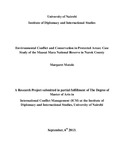| dc.contributor.author | Matolo, Margaret | |
| dc.date.accessioned | 2013-11-22T07:09:57Z | |
| dc.date.available | 2013-11-22T07:09:57Z | |
| dc.date.issued | 2013-09-06 | |
| dc.identifier.citation | Master Of Arts In International Conflict Management (ICM) At The Institute Of Diplomacy And International Studies, University Of Nairobi,2013 | en |
| dc.identifier.uri | http://erepository.uonbi.ac.ke:8080/xmlui/handle/123456789/59832 | |
| dc.description.abstract | The relationship between environment and conflict has been in existence for a while.
International wars have been fought over access to land and water since biblical times. Indeed,
the link between environmental resources and the outbreak of international conflict has been
recognized for decades. The distinction between modern day analysis on environmental conflicts
and old is the recognition that population growth plays a big role in fomenting conflict and the
distinction between non-renewable and renewable resources. This research looked into the
relationship between environmental conflict and conservation. Of focus here shall be: Do
protected areas contribute to conflict to surrounding communities? How do protected areas
contribute to environmental scarcity? Which factors interact with environmental scarcity to
foment conflict? What forms of conflict (s) have resulted due to environmental scarcity? Conflict
model by Karl Marx is the conceptual framework that this study employs. Marxism asserts that
special interest groups fight over scarce resources of society; interest groups fight to gain
advantages over others and that competition puts society off-balance until dominant group gains
control and stability through power. The resources under competition here are water and land.
The methodology employed is case study; the area under study being the Narok County as it is
the surrounding community to the protected area- the Maasai Mara National Reserve.
This study finds that natural resource scarcity and competition can directly or indirectly lead to
conflict in communities. Directly is where different groups directly compete to access pasture
and water. Indirectly is where environmental scarcity or lack of resources lead to conflict in
combination with other factors like political, economic, cultural, climatic and management to
foment conflict. At the upper end fuelling this interaction to conflict is poverty. The conflict that
is witnessed in Narok County is not violent but a non-violent one that has been fomenting over a
long time. Root causes of natural resource scarcity interact with ensuing scarcity and the effects
of scarcity to foment conflict.
Finally, this study recommends the establishment of good Community Based Natural Resource
Based Management (CNRBC) that will go a long way in reducing the negative feelings that the
locals harbour towards the MMNR. The Maasai community does not legally benefit from the
existence of the PA, they just lack enough incentives to protect them. The community is not also
given the opportunity to participate in the management process, are alienated from the resources
and are seen as obstacles to the conservation efforts in MMNR. The Maasai community has a
right to the MMNR as they are the de facto managers of the resources found in it by virtue of
their remote location; their proximity. CNRBC will provide equitable and transparent
mechanisms for communication and decision making. This will build up on traditional
mechanisms for resolving disputes among communities over resources to avert conflict that
easily arise in the absence of fair benefit-sharing. | en |
| dc.language.iso | en | en |
| dc.publisher | University of Nairobi. | en |
| dc.title | Environmental conflict and conservation in protected areas: Case study of the Maasai Mara National Reserve in Narok County | en |
| dc.type | Thesis | en |
| local.publisher | Institute Of Diplomacy And International Studies, | en |

